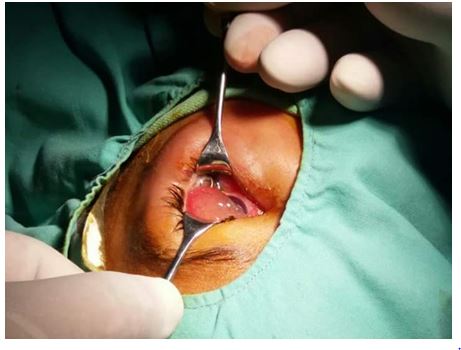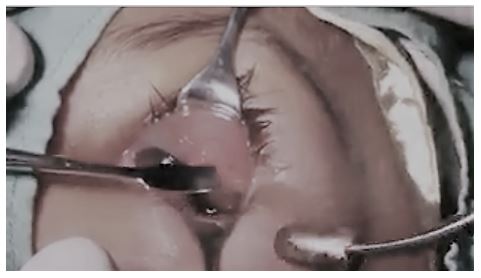Muhammad Saqib, MCPS, FCPS1, Zamir Iqbal, FCPS2, Faheem Feroze, FCPS3
1Classified Anesthesiologist, Department of Anesthesiology, Combined Military Hospital Kohat (Pakistan); E-mail: bandeshah65@yahoo.com
2Classified Ophthalmologist, Department of Ophthalmology, Combined Military Hospital
Kohat (Pakistan); E-mail: drzamiriqbal@yahoo.com
3Classified Anesthesiologist, Department of Anesthesiology, Combined Military Hospital Kohat (Pakistan); E-mail: faheemferoze2008@gmail.com
Correspondence: Dr Muhammad Saqib, MCPS, FCPS, Department of Anesthesiology, Combined Military Hospital Multan (Pakistan); Mob No: +923214792234; E-mail: bandeshah65@yahoo.com
ABSTRACT
Ocular trauma is an important cause of morbidity and occurs more often in children especially under the age of five years; however, all ages are prone to it. Use of tear gas, chillies and pellet guns has led to increase in the cases of ocular trauma. A focused history and prompt ocular examination are essential to immediate management. We present a report of an eight year old child who sustained penetrating eye injury by a bullet which accidently got fired from a heap of burning garbage. The bullet entered the eye ball and landed into the vitreous. It was an interesting case for the civic education that no live or misfired bullets should be thrown into the garbage.
Key words: Penetrating eye injury; Bullet injury eye; Ophthalmology, emergency
Citation: Saqib M, Iqbal Z, Feroze F. An unusual penetrating eye injury by a bullet. Anaesth Pain & Intensive Care 2017;21(4):482-484
Received: 22 Nov 2017; Reviewed: 24 Nov 2017; Corrected & Accepted: 24 Nov 2017
INTRODUCTION
Vision is a blessing of Allah and one of the most valued senses. Intact binocular vision plays an important role in development, independence, quality of life, and personal safety. Ocular injury is a frequent and preventable cause of visual impairment. The lifetime prevalence of sustaining any type of ocular trauma approaches 19.8%.1 Eye injuries have a broad range of severity, from a small corneal epithelial abrasion to the more severe penetrating and globe rupture injuries. Regional conflicts, combat operations and warlike conditions in different regions have led to increase in the cases of eye injuries. Recent use of pellet guns in Indian Occupied Kashmir has left many youngsters with blind eyes. The pediatric age group accounts for one third of all eye injuries.2 Pediatric ocular injury is usually accidental and uniocular. In contrast, adult ocular injury is usually the result of intentional assault. Males are more often affected than females, at a rate approximating 4:1, and suffer injury at a younger age.3 Prompt evaluation and appropriate management of ocular injuries are paramount in the preservation of vision. Visual acuity, presence of an afferent pupillary defect, the type of injury, the location, and extent of penetrating injury, type of lens damage, presence and severity of vitreous hemorrhage, presence and composition of intraocular foreign bodies mostly contribute to the final visual outcome in patients suffering penetrating ocular injuries. We describe the evaluation and management of penetrating injury by a bullet from burning garbage in an eight year old male child.
CASE REPORT
A eight year old male child presented with severe pain and swelling of the left eye. According to the child he was going to school in the morning while passing near a heap of burning garbage he was suddenly hit by some object which pierced into his left eye. He was brought to eye outpatient department with severe pain, swelling and photophobia. X-ray of the left orbit showed a metallic object inside. Ultrasonography and computerized tomography were also done to confirm the position of the foreign body which was a bullet in the posterior chamber of the eye ball. Interesting thing in this case was that the bullet had directly entered the eye ball. There was no wound in the skin of the orbit or eyelid. The bullet directly hit the eyeball, burnt a hole in it and landed in the posterior chamber. The child was kept nil per orally for eight hours and then under general anesthesia bullet was removed by direct approach. Propofol, atracurium, nalbuphine, oxygen, sevoflurane anesthesia was given and succinylcholine was avoided because it increases the intraocular pressure. After removal of foreign body systemic and local antibiotics were given. Two weeks later the wound healed but the child had had only light perception in his left eye. He was referred to tertiary care hospital for further disposal.

Figure 1: Exposure of the bullet in the eyeball

Figure 2: Removal of the bullet from the eyeball
DISCUSSION
Ocular trauma is the cause of blindness in approximately half a million people worldwide, and many more have suffered partial loss of sight.4 It is often the most important cause of unilateral loss of vision, particularly in developing countries. Males, young adults and lower socioeconomic classes are more associated with ocular trauma. Due to severity of ocular trauma, majority of them have poor visual outcome.5 The setting for the occurrence of trauma is most commonly the workplace. In some countries like Iraq, Syria, Afghanistan and Pakistan warlike conditions and suicidal terrorist attacks with bombs containing ball bearings have left many with blind eyes. Use of teargas shells/pellet guns, road accidents and mines and improvised explosive devices (IED) blasts are common causes of eye injuries in some countries.6 Children are targeted in trouble areas by terrorists with mines in the form of toys. On the other hand, the incidence of domestic accidents is probably under-reported. Of particular importance in some developing countries is the occurrence of superficial corneal trauma in agricultural work, often leading to rapidly progressing corneal ulceration and visual loss.4 Open globe injuries, especially ruptured globes, had the worst visual outcomes. Vitreous hemorrhage followed by open globe injury is usually associated with very poor prognosis.7 Delayed presentation is associated with very poor prognosis, and early referral to eye specialist can improve outcome. Ocular trauma in children is associated with visual loss. Many of the cases are preventable. There is a need for education and awareness of children in terrorism hit areas about mines disguised in the form of toys. Ocular trauma in childhood is more frequent in the male school children and is mostly due to injury with agents like stone, wood and iron pieces, domestic utensils and leisure objects8. These injuries occurred most frequently at home. Our case was unusual in that the injury was caused by a bullet, which had not been fired from a fire arm, rather it had been dumped in the garbage and got fired by the fire. Secondly, it hit directly the exposed sclera and got seated in the vitreous, without leaving any entry wound on the peribulbar skin.
CONCLUSION
Ocular trauma is an important cause of blindness in children and needs attention of all circles of life. Timely presentation to the medical setup can save vision of many patients. Education of the parents and children regarding ocular trauma can decrease the incidence of blindness up to a significant extent.
Conflict of interest: None declared by the authors
Author contribution: All of the authors took part in the management of the case and the preparation of the manuscript
REFERENCES
- Guthe SP, Darade P, Survashe P, Velho V. Posttraumatic herniation of eyeball: A rare case. Med J DY Patil Univ 2016;9:747-9. [Free full text]
- Khaqan HA, Chaudhry HR, Ilyas S, Hye A. Pattern of Ocular Trauma in Tertiary Care Hospital. Pak J Ophthalmol. 2017;33:2. [Free full text]
- Massa R, Ferreira N, Meireles A. Trends in the epidemiology of ocular trauma:comparison of two periods of time Oftalmologia 2014;38:259-264. [Free full text]
- Malik IQ, Ali Z, Rehman A, Moin M, Hussain M. Epidemiology of Penetrating Ocular Trauma. Pak J Ophthalmol. 2012;28(1):14-16. [Free full text]
- Chakraborti C, Giri D, Choudhury KP, Mondal M, Datta J. Paediatric ocular trauma in a tertiary eye care center in Eastern India. Indian J Public Health. 2014 Oct-Dec;58(4):278–80. [PubMed] [Free full text]
- Maurya RP, Singh VP, Yadav I, Singh MK, Mishra CP, Sen PR, et al. Profile of pediatric ocular trauma at a tertiary eye care centre in Northern India. Indian Journal of clinical and Experimental Ophthalmology. 2015;1(2):7-1. [Free full text]
- Islam QU, Ishaq M, Yaqub MA, Mehboob MA. Predictive value of ocular trauma score in open globe combat eye injuries. J Ayub Med Col Abbottabad. 2016 Jul-Sep;28(3):484-8. [PubMed] [Free full text]
- Godar ST, Kaini KR, Amatya P, Joshi K, Singh L. Magnitude of ocular trauma in a tertiary care hospital of western Nepal. Nep J Med Sci. 2013;2(2):141. [Free full text]
- Abbott J, Shah P. The epidemiology and etiology of pediatric ocular trauma.Surv Ophthalmol. 2013 Sep-Oct;58(5):476-85. doi: 10.1016/j.survophthal.2012.10.007. [PubMed]

